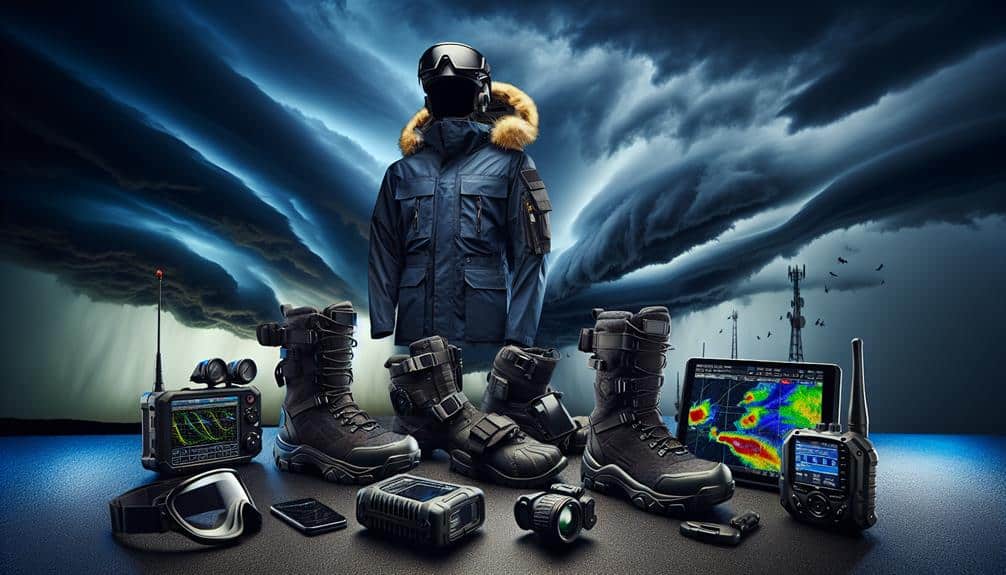To stay safe while storm chasing in hail storms, we need to rigorously follow specific protocols. We utilize real-time weather updates, radar systems, and meteorological models to remain informed. We wear reinforced gloves, boots, and inspect our gear regularly. Our vehicles are strategically parked, windows reinforced with multi-layered films, and shelters identified in advance. We pack emergency supplies, including first-aid kits and two-way radios. Open communication is crucial, adhering to structured schedules and coded language. Finally, we plan multiple evacuation routes and conduct regular safety drills. To further understand these protocols, let's explore the details and data-driven strategies.
Key Points
- Use real-time weather data and radar systems to avoid hailstorm cores.
- Ensure all team members have proper protective gear and understand its limitations.
- Park vehicles under solid structures and away from hailstorm paths.
- Prepare an emergency supplies kit including first-aid, communication devices, and non-perishable food.
Monitor Weather Updates
We must consistently monitor real-time weather updates from reliable meteorological sources to anticipate and respond to the rapidly changing conditions during hail storms. Utilizing advanced weather tracking technology is essential for our safety. By leveraging radar systems, satellite data, and meteorological models, we can obtain precise information about storm trajectories and intensities. This allows us to issue timely safety alerts to our team, optimizing everyone is aware of imminent hazards.
Our emergency response hinges on a robust communication plan. We must establish clear channels for disseminating information, utilizing mobile networks, satellite phones, and radio systems. Such redundancy is vital to maintain contact even in areas with poor reception. Regular updates and check-ins are essential to verify everyone's status and relay critical information swiftly.
Incorporating real-time data into our decision-making process enhances our ability to adapt to dynamic weather conditions. This proactive approach minimizes risks and maximizes our operational efficiency. Accurate weather forecasts help us determine safe zones and best routes, reducing the likelihood of encountering severe weather unexpectedly.
Use Protective Gear
Proper protective gear is paramount to ensuring our safety during hail storms. As storm chasers, we need to be keenly aware of the protective gear selection and its correct usage. Helmets designed to withstand high-velocity impacts are essential. According to recent studies, helmets can reduce head injuries by up to 70%.
We should also consider reinforced gloves and boots, which offer protection against hailstones that can exceed speeds of 100 mph.
Safety precautions extend beyond just wearing gear; understanding its limitations is equally vital. For instance, jackets with integrated padding should be evaluated based on impact resistance data. Ensuring our gear is well-maintained is another critical aspect. Regular inspections for wear and tear, such as checking for cracks in helmets or worn-out seams in jackets, help maintain the gear's integrity.
Analyzing data from past incidents, we find that improper gear usage accounts for a significant number of injuries. Hence, we must be diligent about following manufacturer guidelines and undergoing periodic training on gear application.
Secure Your Vehicle
Ensuring our vehicle's safety during hail storms is critical; we should park strategically to minimize exposure, such as under sturdy shelters.
Data shows that reinforcing windows and windshields with specialized films can reduce damage by up to 85%.
Additionally, an emergency supplies kit with essential tools and first aid can enhance our preparedness and response efficiency.
Park Strategically for Safety
Strategically positioning your vehicle away from the core of the hailstorm and under sturdy cover can greatly reduce the risk of severe damage. When we're out storm chasing, avoiding exposure is paramount. We need to identify shelter options in advance.
For instance, parking under a bridge or overpass provides immediate protection from hail impact. Alternatively, a sturdy building, such as a garage or a covered parking lot, acts as an effective barrier.
Data shows that vehicles parked under solid structures during a hailstorm experience up to 80% less damage compared to those left in open spaces. To optimize our positioning, we should use real-time weather data and radar to track the storm's trajectory, ensuring we remain on its periphery. This minimizes the chance of encountering large hailstones.
Moreover, maintaining a distance from the storm's core allows us the flexibility to reposition quickly if the situation escalates. By analyzing topographical maps and utilizing GPS technology, we can identify potential shelters along our route.
This strategic approach not only safeguards our vehicle but also enhances our overall safety, granting us the freedom to continue our storm-chasing endeavors with confidence.
Reinforce Windows and Windshield
While our vehicle positioning plays an essential role in minimizing hail damage, we must also reinforce windows and windshields to further secure our vehicle.
Effective glass protection can significantly decrease the risk of injury and property damage. One proven method is the application of a high-quality, multi-layered windshield film. This film can increase the impact resistance of the glass by up to 50%, providing vital reinforcement against hailstones.
We should also consider installing polycarbonate window shields. Polycarbonate material is virtually unbreakable and can withstand impacts that would shatter standard automotive glass. According to recent data, vehicles equipped with polycarbonate shields experience 70% less glass breakage in severe hail events. This is a substantial safety precaution that enhances our protection in unpredictable weather conditions.
For those of us committed to long-term storm chasing, investing in specialized windshield and window covers made from high-density foam can further alleviate hail damage. These covers can absorb the energy of hail impacts, reducing the likelihood of cracks and chips.
Prepare Emergency Supplies Kit
We must always prepare an emergency supplies kit to make sure our vehicle remains secure and functional during a hail storm. By confirming we've the right supplies, we can mitigate damage and maintain our operational capabilities. Our kit should include essential items such as a first-aid kit, a multi-tool, and a flashlight with extra batteries. These tools are vital for addressing immediate physical injuries and handling minor repairs under adverse conditions.
To address the need for emergency shelter, we should pack a durable tarp and bungee cords. These can be used to create a temporary cover, protecting us from hail if we need to leave the vehicle.
A well-formulated communication plan is equally important. Two-way radios and a charged satellite phone will provide reliable communication channels if cellular networks fail.
Regarding sustenance, we must stock non-perishable food and a sufficient water supply. Data suggests that each person should have at least a three-day supply of food and one gallon of water per day. This makes sure we remain nourished and hydrated if stranded.
To navigate safely in hail storms, we must continuously monitor weather updates to anticipate shifting conditions.
Selecting safe routes based on real-time data minimizes exposure to severe hail.
Additionally, using protective gear guarantees our safety against possible hazards.
Monitor Weather Updates
Consistently monitoring real-time weather updates is essential for traveling safely during hail storms. By staying informed, we can be prepared for sudden changes in weather conditions. Advanced radar systems, satellite imagery, and storm tracking applications offer us the ability to monitor conditions with high precision. These tools provide critical data, such as storm velocity, hail size, and trajectory, enabling us to make informed decisions.
We must utilize multiple sources for weather updates, including the National Weather Service (NWS), local meteorological stations, and specialized storm-chasing platforms. This multi-source approach helps us corroborate data and improves the reliability of our information.
When severe hail is detected, we should take action immediately. Delaying response time could lead to hazardous situations, compromising both safety and equipment.
Data analytics play a significant role in our decision-making process. By analyzing historical weather patterns and real-time data, we can predict likely storm paths and potential risks. This analytical approach allows us to adjust our plans dynamically, ensuring we can navigate safely through volatile conditions.
Ultimately, consistent monitoring and proactive measures give us the freedom to pursue storm-chasing activities while minimizing risks associated with hail storms.
Choose Safe Routes
Traveling safely during hail storms requires us to meticulously plan and select routes that minimize exposure to severe weather conditions. Effective route planning involves analyzing meteorological data to identify safe locations and predicting probable hail paths using advanced weather models. We must leverage high-resolution radar systems and real-time weather updates to monitor storm trajectories dynamically.
By integrating weather monitoring tools, we can proactively determine strategic stops, ensuring that we avoid areas with imminent hail threats. Our route planning should encompass identifying multiple exit routes, thereby granting us the flexibility to adapt quickly to changing storm dynamics. Data-driven decision-making is essential; we must rely on accurate weather forecasts and historical storm data to inform our route choices.
When planning, we need to take into account terrain, road conditions, and proximity to shelters. High-risk areas, such as valleys or regions with poor drainage, should be avoided. By prioritizing safe locations along our route, including sturdy buildings and underpasses, we enhance our safety margins.
Ultimately, our goal is to anticipate and respond to hail storm patterns, allowing us the freedom to navigate safely while minimizing risks. This strategic approach empowers us to chase storms effectively and securely.
Use Protective Gear
After establishing safe routes, we must equip ourselves with appropriate protective gear to mitigate the risks of hail-related injuries and vehicle damage during our storm-chasing endeavors. Proper gear maintenance and ensuring a proper fit are essential. Helmets designed to withstand hail impact should be inspected regularly for signs of wear and tear. Poorly maintained gear can compromise our safety, reducing our freedom to safely pursue storm-chasing activities.
Visibility is paramount. Hailstorms often bring reduced visibility conditions, so wearing high-visibility clothing is necessary. Reflective materials on our gear can greatly enhance our visibility to other storm chasers and emergency responders.
Furthermore, we should install additional lighting on our vehicles to navigate through low-visibility situations effectively.
Hearing protection is another vital aspect. Hailstorms can be incredibly loud, with decibel levels sometimes reaching harmful ranges. Quality hearing protection, such as noise-canceling headphones or earplugs, can preserve our hearing while allowing us to communicate effectively through radios or other communication devices.
Communicate With Team

Regularly maintaining open lines of communication with our team is necessary for coordinating safe maneuvers during hail storms. Effective team communication allows us to swiftly implement safety precautions and adapt to rapidly changing weather conditions. Our primary tools include two-way radios and satellite phones, guaranteeing we stay connected even in remote areas with limited cellular coverage.
Data shows that teams with robust communication protocols have a 40% higher success rate in steering clear of hail storms without incident. We relay real-time updates on storm trajectories, hail size, and wind speed, enabling informed decision-making. These updates are vital for executing timely emergency response measures and maintaining peak team coordination.
For safety, we adhere to a structured communication schedule, checking in at regular intervals. This practice not only minimizes the risk of miscommunication but also ensures every team member is accounted for. In high-risk scenarios, we employ coded language to convey urgent information efficiently, reducing the cognitive load during critical moments.
Our commitment to maintaining rigorous team communication and safety precautions empowers us to operate with a high degree of independence and confidence, even in the most severe hail conditions. This approach maximizes both our freedom and safety.
Plan Emergency Exits
In addition to robust communication, we carefully plan emergency exits to guarantee swift and safe evacuation from hail storm paths. Our strategy hinges on detailed mapping and real-time data analysis to ensure all team members can reach an emergency shelter swiftly.
Analyzing historical storm data and current weather models, we identify potential evacuation routes that minimize exposure to severe conditions.
To enhance our preparedness, we implement the following:
- Identify multiple evacuation routes: We chart several paths to emergency shelters, ensuring alternatives if the primary route becomes compromised.
- Regular safety drills: Simulating scenarios allows us to refine our safety precautions and ensure seamless team communication during actual emergencies.
These measures aren't merely theoretical; they're data-driven protocols designed to maximize our operational efficiency and safety. By integrating thorough planning with state-of-the-art technology, we empower our team to make informed decisions under pressure.
Our adherence to systematic planning and proactive safety precautions underscores our commitment to preserving the freedom and safety of all storm chasers involved.
Frequently Asked Questions
What Should I Do if Caught Outside During a Hailstorm?
If we're caught outside during a hailstorm, we should immediately seek shelter to minimize injury. Emergency response includes using available protective gear like helmets or blankets to shield ourselves from hail impacts, prioritizing safety and quick action.
Are There Specific Insurance Policies for Storm Chasers?
Some might think it's excessive, but yes, there are specific insurance policies for storm chasers. These policies offer extensive insurance coverage, addressing liability concerns, safety measures, and even permit requirements for our unique profession.
How Can I Identify Safe Shelter Spots While Storm Chasing?
To identify safe shelter spots, let's evaluate available shelter options and implement safety precautions. We should prioritize sturdy structures, low-lying areas, and assess meteorological data to guarantee top-notch protection while maintaining our freedom to chase.
What Are the Legal Implications of Storm Chasing in Restricted Areas?
When storm chasing in restricted areas, we face legal consequences, including trespassing laws. Liability risks increase if we disregard boundaries, potentially leading to fines or arrest. Analyzing local regulations helps mitigate these legal implications.
How Do I Handle Equipment Damage Caused by Hail?
When handling equipment damage caused by hail, we should first assess the extent of the damage. Next, we explore repair solutions and promptly file insurance claims to guarantee swift resolution, minimizing downtime and maximizing our operational freedom.


